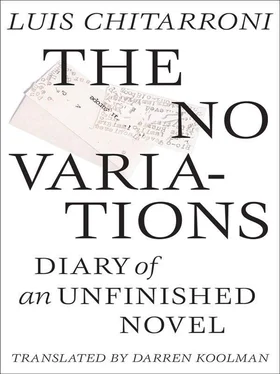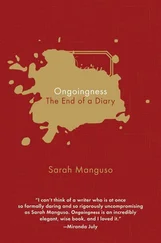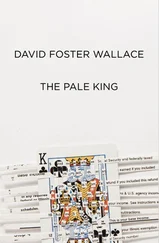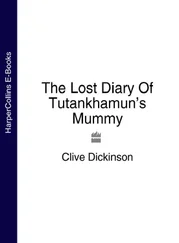Five minutes later, on the same stage, Bambi began performing a routine of disarming delicacy. There were various allusions to the past and present in her dress, which everyone thought marvelously quaint. The little space she had on the stage didn’t matter. Her lithe slender frame moving around the stage seemed to cause time to throw open its arms. My eyes pursued the outline of her cygnean nape, the taut muscles of her back through raven mesh, but when she turned I saw she had a sad face, with false lashes and lips smeared with wax, like an abandoned doll, or an actress in a silent film playing the role of a garreted spinster. Then she began her performance. She opened with a recitation — interspersed with oscitations and eructations — of a monologue by the teenage actress in The Seagull . Then she turned to the audience and mewed some passages by Brecht: the effect being of a cat that fell down a sewer, surprising a plague of rats. Then she performed a Bovary that was worthy of a dose of Arsenic, a Karenina deserving of being flung under a train, and the audience responded with a muted applause, hoping she would end it there. But she continued with her own version of Cathy Berberian’s Stripsody vocal. Then she performed imitations of Marlene Dietrich, Patsy Cline, and a tango vocalist named Libertad Lamarque, before concluding with an a capella from Wagner’s Ring Cycle that was so lugubrious we all demanded she transport us back to the present immediately. The performance ended with a last vocal flourish and a gesture of painful defiance. All that remained was for the DJ to yodel his own farewell. During the set, I suppose the Diva was explaining her life to me, a tragic life, which had been preserved only by the most delicate means.
Then James, [apparently] invigorated after his third pint, finally told us everything. But his account was confused, clumsy, inarticulate, erroneous, and — in many respects — untrue. It was an account in which he described people of dubious intellectual accomplishments, but in which he made use of every superlative to exaggerate those accomplishments. An account moreover obscured not only by alcohol but by his insisting on playing a cute rhetorical game (which I tried to ignore to get to the heart of his narrative) in which he reversed greater and lesser degrees of comparison. So, for example, “extremely” was less extreme than “very,” “tremendous” less tremendous than merely “good” or “nice,” “invaded and usurped” more lenient than “landed and solicited.” Most of the time, success in these sorts of exercises depends on the personality of the performer. Homer, for example, paid no heed to the sequencing of events when it came to their telling and retelling. And Jesus, whose biggest hit was the Sermon on the Mount, suggested a disproportioning perspective on the qualities of the blessed. And so it was with James, sitting there with his flat face and want of a neck — far from Byronic — hardly a profile to be printed on freshly minted coins. He was more a Jeffrey Aspern lookalike. In brief, from his terrible account, we managed to decipher that we had to hit the ground running if we wanted to save the father of St. Mawr.
An hour later, the rescue party had been organized. Thanks to Honor’s intervention, we managed to secure the services of Hulot, a magnanimous canine, a chien de St.-Hubert , or what the English call a bloodhound , whose owner had been absent from the meeting. Arthur Conan Doyle’s famous story is often translated in Spanish as “The Bloodhound of the Baskervilles.” But when the reader conjures up the image of a bloodhound’s face — those drooping ears, those melancholy jowls, those large compassionate eyes — he forgets all about the monster of the story. He thinks instead of a loyal companion, a friend, dedicated to searching for what’s lost, to sniffing out any false trails. He thinks of that little mongrel mascot who’s first introduced in The Sign of Four : one of the most memorable scenes in all of Holmes.
— Christine Knowles — said Bambi — now calls herself Charmian to seem more distinguished. I knew that sooner or later she’d show her harpy’s claws. I got to know her on the West End — the worst actress I ever saw. Onstage, she looked like a useless piece of furniture, one of those garish ornamental pieces collecting dust in the mansions of impotent inbred aristocrats. Poor woman, she eventually married an American professor [of English Literature] and dedicated her life to her kids …
— What’s wrong with Americans besides the fact they’re all born with a natural incapacity to properly speak The language? — said Hope.
— They speak with an accent — said James — that’s their only fault. And, as long as they don’t become fans of some baseball team or other, it will remain their only fault.
As if she wasn’t listening, Bambi continued:
— Now she forced her kids to do horrendous doodles, assuring them they’re enriching contemporary art …
— Not that there’s anything original in that — said Hope—. The task was begun years ago by Sir Herbert Read.
We entered the deserted house, a shed or hangar with a gigantic sofa in the middle. The tip of Bambi’s cigarette was our only source of light, and that was swallowed by the darkness after every drag … until the bearer of the torch managed to find the switch. Dazzled, we glanced in every direction. Hulot began barking. As Bambi anticipated before entering, there were no ashtrays; and, as she foresaw in her earlier comment, the walls were covered in childish doodles resembling those of Dubuffet [genre, realist]. One wall, however, the one we happened to be facing, was the only one depicting something symbolic, a fairy tale. It was a cartoon of the cottage in which Hansel and Gretel lived after they poisoned the original owner with a blowgun they borrowed from Beddoes, and afterwards, burnt her with the help of Giordano Bruno. Then, from the doorway of this Trompe-l’œil, emerged a very tall though fleshy woman in dowdy dress, a fashion victim in every sense, holding an aerosol can in her hand.
— Who are you people and what are you doing in my house?
— You’re ruining our fun, Sophonisba — said Bambi casually, looking straight at her—. Perhaps you don’t recognize me?
— If you don’t get out of here right now, I’m going to scream …
— You’re already screaming — observed Hope.
— Get out, you tourists, you gawkers! This is the house of St. Mawr!
— Mary and Joseph didn’t own the manger, heretic.
— Ever since we got married, Woodrow and I wanted to give all English children the opportunity to get to know their favorite literary characters … That’s why St. Mawr had to be born here, because the children deserve to be surrounded by their favorite literary characters.
— If all that’s true, why didn’t you kidnap Bambi? — asked James sensibly, surreptitiously.
— Shut your mouth, I’ll have you know the president of the institution supports us.
— You take a risk at covering up what can be easily uncovered by us.
James rushed the sofa, which no longer faced us but seemed to have us corralled in the corner of the room, provoking a mock chase and a change of position worthy of comic scene in a silent movie. Now Christine Knowles Kinsey stood where we were standing thirty seconds before. Hulot spent the whole time reclining comfortably on the sofa. The second period of the shouting match began when Bambi said brashly:
— Triste, the father of St. Mawr, belongs to us. Malanoche, the daughter of Noctámbula and Padrenuestro, and Nabucodonosor, the son of Casualidad and Monaguillo, together begat Comino; and Comino lay with Aldebarán and begat Úkase, and Úkase lay with Solombra or Sansueña — sister (night)mares — and begat Triste. The sky was indifferent. The clouds were like ash. Or maybe chalk …
Читать дальше












